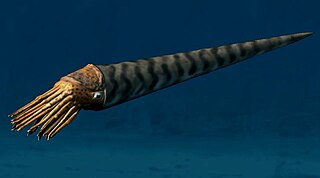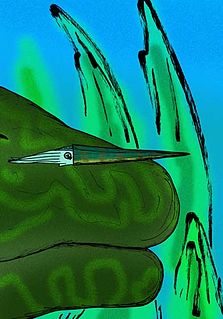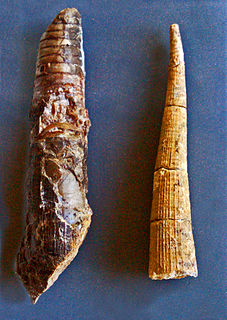Related Research Articles

Orthoceras is a genus of extinct nautiloid cephalopod restricted to Middle Ordovician-aged marine limestones of the Baltic States and Sweden. This genus is sometimes called Orthoceratites. Note it is sometimes misspelled as Orthocera, Orthocerus or Orthoceros.

Orthocerida is an order of extinct Orthoceratoid cephalopods also known as the Michelinocerida that lived from the Early Ordovician possibly to the Late Triassic. A fossil found in the Caucasus suggests they may even have survived until the Early Cretaceous. They were most common however from the Ordovician to the Devonian.

Sculpture is a feature of many of the shells of mollusks. It is three-dimensional ornamentation on the outer surface of the shell, as distinct from either the basic shape of the shell itself or the pattern of colouration, if any. Sculpture is a feature found in the shells of gastropods, bivalves, and scaphopods. The word "sculpture" is also applied to surface features of the aptychus of ammonites, and to the outer surface of some calcareous opercula of marine gastropods such as some species in the family Trochidae.

Endoceras is an extinct genus of large, straight shelled cephalopods from the Middle and Upper Ordovician that gives its name to the Nautiloid order Endocerida. The cross section in the mature portion is slightly wider than high, but is narrower laterally in the young. Sutures are straight and transverse. Endoceras has a large siphuncle, located close to the ventral margin, composed of concave segments, especially in the young but which may be tubular in the adult stage. Endocones are simple, subcircular in cross section, and penetrated by a narrow tube which may contain diaphragms reminiscent of the Ellesmerocerid ancestor.

Arcestes is a genus of extinct ceratitid ammonites found in Triassic-aged marine strata.
The Ellesmerocerida is an order of primitive cephalopods belonging to the subclass Nautiloidea with a widespread distribution that lived during the Late Cambrian and Ordovician.
Gurmatia is an extinct small genus of pyramidellid gastropod mollusks or micromollusks in the family Pyramidellidae.
Actinoceras is the principal and root genus of the Actinoceratidae, a major family in the Actinocerida, that lived during the Middle and Late Ordovician. It is an extinct genus of nautiloid cephalopod that thrived in the warm waters of the United States during the Paleozoic era.

Lamellorthoceratidae is a family of fossil orthoceratoids in the Orthocerida, defined by Curt Teichert in 1961. The lamellorthoceratids are placed in the superfamily Orthocerataceae in the Treatise on Invertebrate Paleontology.
Heteroceras is a Lower Cretaceous heteromorph ammonite belonging to the ancyloceratacian family, Heteroceratidae, characterized by a helically coiled juvenile shell at the apex followed by slightly curved adult shaft, with a J-shaped section at the end of it. The shell is ribbed; ribs are concave and oblique on the helix, straight and transverse on the later stages.

Kionoceras is an extinct nautiloid cephalopod genus included in the orthocerid family Kionoceratidae with scattered worldwide distribution from the Middle Ordovician to the Lower Permian. Kionoceratids are orthocerids with prominent longitudinal ornamentation on their shells, sometimes augmented by secondary transverse ornamentation. Orthocerids are, of course, prehistoric nautiloides with generally straight and elongate shells, mostly with central or subcentral siphuncles.
Protcycloceratidae is an extinct family of slender, commonly annulate, members of the cephalopod order Ellesmerocerida that lived during the Early Ordovician.

Burnupena papyracea, common name the papery burnupena, is a species of sea snail, a marine gastropod mollusk in the family Buccinidae, the true whelks.
Kobyashiceras is an extinct genus in the cephalopod order Actinocerida, from Lower Devonian marine sediments in Japan. The type and sole included species is Kobayashiceras gifuense. The generic name honors the late Dr. Teiichi Kobayashi who contributed greatly to the study of Paleozoic cephalopods. The specific name is derived from Gifu, the name of the prefecture in which the type locality is found.

Tibia insulaechorab, common name the Arabian tibia, is a species of sea snail, a marine gastropod mollusk in the family Rostellariidae. It is native to the Red Sea and the Horn of Africa.
Pentameroceras is a straight to slightly exogastric breviconic oncocerid from the middle Silurian of North America and Europe belonging to the Trimeroceratidae.
Hesperoceras is an orthocerid cephalopod belonging to the subfamily Michelinoceratinae which comes from the lower Mississippian of New Mexico.
Polygrammoceras is an orthoconic nautiloid that lived during the period from the middle Ordovician to the early Devonian in what is now North America and Eurasia.

Geisonoceras is an extinct orthocerid genus named by Hyatt, 1884, and type for the Geisonoceratidae established by Zhuravleva in 1959.
Danoceras is an essentially straight shelled oncocerid named by Troedsson in 1926, and included in the Diestoceratidae. It has been found in the upper, and possibly middle, Ordovician of Europe, (Estonia), Greenland, and Russia,. Named species include Danoceras ravni, type, D. inutile, D. scandinavicum, and D. skalbergensis.
References
- Sweet, Walter C. 1964. Nautiloidea-Orthocerida. Treatise on Invertebrate Paleontology, Part K. Geological Soc of America, and Univ Kansas Press.